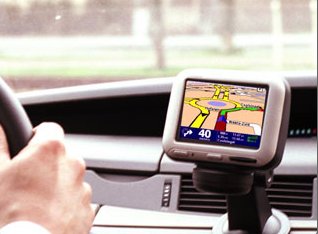Device Profile: TomTom Go in-car GPS navigation system
Oct 29, 2004 — by LinuxDevices Staff — from the LinuxDevices Archive — 15 viewsThe TomTom Go is a Linux-based in-car GPS navigation system available with or without preloaded maps. The device mounts to the dashboard or windshield, providing a 3D view of the road ahead, as well as text-based and spoken driving directions. TomTom claims it is the smallest car navigation device available.

The TomTom Go offers point-to-point navigation
Unlike the Linux-based 3D in-car navigation system launched in June by Sony, the Go does not appear to offer multimedia features such as video playback.
The Go features an integrated 12-channel GPS unit with “assisted satellite navigation” features that attempt to guess location even in tunnels, near tall buildings, or in other places where GPS signals can fail.
The Go reads local maps from removable SD cards. Limited locations appear to be available, currently, but a form on TomTom's website lets users sign up for notification when their country becomes supported.
Regional maps provide drivers with flat or 3D views of their location, with icons calling attention to “points of interest” such as gas stations, restaurants, or, presumably, other advertising partners.
Point-to-point navigation enables users to type in a street address, using a touchscreen interface with look-ahead menus (Screenshot). The Go then attempts to navigate the user to their destination with highlighted maps (including 3D maps), text-based directions, and/or optional voice directions.
The TomTom Website lists supported languages as: “Available in Dutch, English, German, French, Italian, Spanish, Danish, and Swedish, plus spoken instructions in Belgian Dutch and Norwegian.”
Should a road closure or other obstacle block the route chosen by the Go unit, the user can request re-routing using the “roadblock” interface (screenshot). A low-glare night-time option offers a choice of several display modes optimized for low-light viewing (screenshot).
The 11-ounce (310-gram) Go measures 4.5 x 3.6 x 2.2 inches, and has a sleek, rounded look. A lithium-ion battery is said to provide 5 hours of operation. A supplied car lighter cable or wall-wart can be used to recharge the device. The device is available in a number of different faceplate and backplate colors. An optional “car kit” can be used to wire the device into a car audio system.
What's under the hood?
The Go is based on an Intel XScale processor with a 200MHz ARM920T core. It boots from Flash memory into 32MB of RAM. The display is a quarter-VGA (320×240) TFT LCD touchscreen. The Go includes an integrated 12-channel GPS receiver with built-in antenna, and “all-in-view” tracking.
I/O ports include:
- SD memory slot for cards containing regional maps
- mini-USB device port
- integral loudspeaker
- power charging jack
An optional “car kit” enables the unit to be hooked up to the car stereo. It includes a power supply, audio out, audio mute, and audio in, as well as “disconnection signals.”
On the software side, the Go runs version 2.4.18-rmk6 of the ARM Linux kernel. TomTom modified the kernel, adding drivers for specific Go hardware. On its nicely done GPL page, the company provides source patches relative to a specific ARM Linux kernel, and as a full archive including kernel source.
The Go runs an unmodified glibc 2.1.2, along with busybox 1.00-pre8, and modutils. Application software was built using GNU tools.
Availability
The TomTom Go is available from a number of online and other retailers around the world, priced between $650 and $1,000. It ships with a suction cup windshield/dashboard mount, carry bag, screen cloth, documentation, SD card with pre-installed map, Major Roads of Europe and/or US and/or Canada CD (requires Windows PC with CDROM drive, TomTom says), cigarette lighter cable, USB cable, and power adapter.
TomTom also markets GPS and mapping software for PDAs.
This article was originally published on LinuxDevices.com and has been donated to the open source community by QuinStreet Inc. Please visit LinuxToday.com for up-to-date news and articles about Linux and open source.